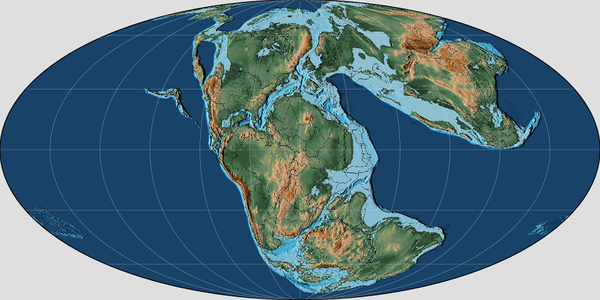Kota Formation
The Kota Formation is a geological formation in India. The precise age of Kota Formation are uncertain, but it dates from the Early to Middle Jurassic, and is split into a Lower Member and Upper Member[1]. The lower member is thought to be Hettangian-Pliensbachian[2]. While the upper unit is thought to be Toarcian, but may possibly extend into the Aalenian.[3] It conformably overlies the Dharmaram Formation which is Late Triassic to earliest Jurassic and is unconformably overlain by the Early Cretaceous Gangapur Formation. The lower member is approximately 100 m thick while the upper member is 490 m thick. Both subunits primarily consist of mudstone and sandstone, but near the base of the upper unit there is a 20-30 metre thick succession of limestone deposited in a freshwater setting.[4]
| Kota Formation Stratigraphic range: Early-Mid Jurassic ~200–174 Ma | |
|---|---|
| Type | Geological formation |
| Sub-units | Lower & Upper members |
| Underlies | Unconformity with the Gangapur Formation |
| Overlies | Dharmaram Formation |
| Thickness | 550–600 m (1,800–1,970 ft) |
| Lithology | |
| Primary | Mudstone, sandstone |
| Other | Limestone |
| Location | |
| Coordinates | 18.9°N 80.0°E |
| Approximate paleocoordinates | 31.6°S 31.9°E |
| Region | Telangana |
| Country | |
| Extent | Pranhita-Godavari Basin |
| Type section | |
| Named for | Kota Village |
 Kota Formation (India) | |
Fossil content

Vertebrates
Indeterminate thyreophoran remains geographically present in Telangana State, India. These were given the name Andhrasaurus by Roman Ulansky in 2014.[2]
| Ornithodires | ||||||
|---|---|---|---|---|---|---|
| Genus | Species | Location | Stratigraphic position | Material | Notes | Images |
| Barapasaurus | B. tagorei | Telangana State | Lower Member | "Scattered remains of more than [six] partial skeletons without skulls, manus, or pes." | [2][5] |  |
| Campylognathoides | C. indicus | Chanda District, Deccan | [6] |  | ||
| Dandakosaurus | D. indicus | "Proximal pubis."[7] | [2] | |||
| Kotasaurus | K. yamanpaliensis[2] | Telangana State[2] | Lower Member | "Nearly complete skeleton without skull."[8] | [2] | |
| Testudinatans | ||||||
|---|---|---|---|---|---|---|
| Genus | Species | Location | Stratigraphic position | Material | Notes | Images |
| Indochelys[9] | I. spatulata | 3 km NNE of Kistapur village, Pranhita River, Kota | Upper member | Carapace fragments[10] | Mesochelydian stem-turtle | |
| Mammaliaformes | ||||||
|---|---|---|---|---|---|---|
| Genus | Species | Location | Stratigraphic position | Material | Notes | Images |
| Gondtherium[1] | B. dattai[1] | |||||
| Kotatherium[11] | K. haldanei[11] | |||||
| Indotherium[12]. | I. pranhitai[12] | |||||
Invertebrates
| Insects[13][14] | ||||||
|---|---|---|---|---|---|---|
| Genus | Species | Location | Stratigraphic position | Material | Notes | |
|
Kotaphialtites |
K. frankmortoni |
Sirpur Taluka, Tasch's K1 outcrop bed 2(A) |
An ephialtitid hymenopteran. | |||
|
Taschigatra |
T. bharataja |
Sirpur Taluka, Tasch's K1 outcrop bed 3(A) |
||||
|
T. tulyabhijana |
Sirpur Taluka, Tasch's K1 outcrop bed 2(A) |
|||||
|
Xyelula |
X. alexandri |
Kota Formation outcrop K-2 |
||||
| Protogryllus | P. (Protogryllus) lakshmi | Kota Formation outcrop K-2 | A protogryllid cricket | |||
See also
- List of dinosaur-bearing rock formations
- Toarcian turnover
- Toarcian formations
- Marne di Monte Serrone, Italy
- Calcare di Sogno, Italy
- Sachrang Formation, Austria
- Posidonia Shale, Lagerstätte in Germany
- Ciechocinek Formation, Germany and Poland
- Krempachy Marl Formation, Poland and Slovakia
- Lava Formation, Lithuania
- Azilal Group, North Africa
- Whitby Mudstone, England
- Fernie Formation, Alberta and British Columbia
- Poker Chip Shale
- Whiteaves Formation, British Columbia
- Navajo Sandstone, Utah
- Los Molles Formation, Argentina
- Mawson Formation, Antarctica
- Kandreho Formation, Madagascar
- Cattamarra Coal Measures, Australia
References
- Prasad GVR, and Manhas BK. 2007. A new docodont mammal from the Jurassic Kota Formation of India. Palaeontologia electronica, 10.2: 1-11
- Weishampel, David B; et al. (2004). "Dinosaur distribution (Early Jurassic, Asia)." In: Weishampel, David B.; Dodson, Peter; and Osmólska, Halszka (eds.): The Dinosauria, 2nd, Berkeley: University of California Press. Pp. 534–535. ISBN 0-520-24209-2.
- Bandyopadhyay, Saswati; Gillette, David D.; Ray, Sanghamitra; Sengupta, Dhurjati P. (2010-03-19). "Osteology of Barapasaurus tagorei (Dinosauria: Sauropoda) from the Early Jurassic of India: OSTEOLOGY OF BARAPASAURUS TAGOREI". Palaeontology. 53 (3): 533–569. doi:10.1111/j.1475-4983.2010.00933.x.
- Goswami, Suparna; Gierlowski-Kordesch, Elizabeth; Ghosh, Parthasarathi (January 2018). "Sedimentology of the Early Jurassic limestone beds of the Kota Formation: record of carbonate wetlands in a continental rift basin of India". Journal of Paleolimnology. 59 (1): 21–38. doi:10.1007/s10933-016-9918-y. ISSN 0921-2728.
- "Table 13.1," in Weishampel, et al. (2004). Page 263.
- Wellnhofer, Peter (1991). "Summary of Lower Jurassic Pterosaurs." The Illustrated Encyclopedia of Pterosaurs. London, UK: Salamander Books Limited. p. 79. ISBN 0-86101-566-5.
- "Table 4.1," in Weishampel, et al. (2004). Page 78.
- "Table 13.1," in Weishampel, et al. (2004). Page 261.
- Datta, P.M.; Manna, P.; Ghosh, S.C.; Das, D. P. (April 2000). "The First Jurassic turtle from India". Palaeontology. 43 (1): 99–109. doi:10.1111/1475-4983.00120. ISSN 0031-0239.
- Joyce, Walter G.; Bandyopadhyay, Saswati (2020-02-11). "A reevaluation of the basal turtle Indochelys spatulata from the Early–Middle Jurassic (Toarcian–Aalenian) of India, with descriptions of new material". PeerJ. 8: e8542. doi:10.7717/peerj.8542. ISSN 2167-8359.
- Datta PM. 1981. The first Jurassic mammal from India. Zoological Journal of the Linnean Society of London, 73:307-312
- Yadagiri P. 1984. New symmetrodonts from Kota Formation (Early Jurassic), India. Journal of the Geological Society of India, 25:514-621
- Mostovski M.B., Jarzembowski E.A. 2000. The first brachycerous flies (Diptera: Rhagionidae) from the Lower Jurassic of Gondwana. Paleontological Journal 34 (Suppl. 3): 367-369.
- Rasnitsyn A.P. 2008. New hymenopteran insects (Insecta: Vespida) from the Lower or Middle Jurassic of India. Paleontological Journal 42 (1): 81-85. Archived 2008-11-21 at the Wayback Machine